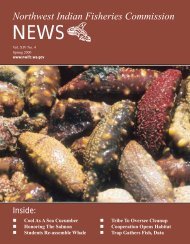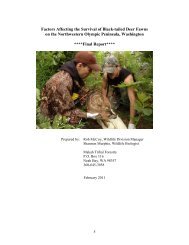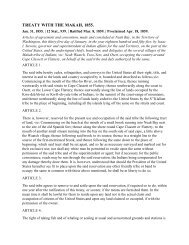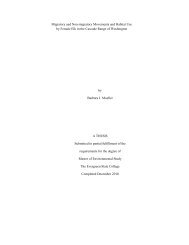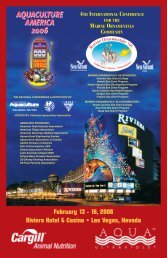Draft TRT Document â for Discussion Purposes ... - NWIFC Access
Draft TRT Document â for Discussion Purposes ... - NWIFC Access
Draft TRT Document â for Discussion Purposes ... - NWIFC Access
You also want an ePaper? Increase the reach of your titles
YUMPU automatically turns print PDFs into web optimized ePapers that Google loves.
<strong>Draft</strong> <strong>TRT</strong> <strong>Document</strong> – <strong>for</strong> <strong>Discussion</strong> <strong>Purposes</strong> – OK to circulateThe Puget Sound Chinook salmon <strong>TRT</strong> established five “Geographic Regions”(Figure 6) within the ESU (Ruckelshaus et al. 2002). These geographic regions wereestablished to provide population spatial distribution “…based on similarities inhydrographic, biogeographic, and geologic characteristics of the Puget Sound basin andfreshwater catchments, which also correspond to regions where groups of populationscould be affected similarly by catastrophes (volcanic events, earthquakes, oil spills, etc.)and regions where groups of populations have evolved in common (Ruckelshaus et al.2002).” In doing so the <strong>TRT</strong> created de facto MPG subdivisions by requiring <strong>for</strong> futureviability that one of each life history type (e.g. spring- and fall-run) be represented in eachgeographic region where they currently exist.Puget Sound Steelhead MPG DeterminationsThe geographic region template developed <strong>for</strong> Puget Sound Chinook salmon(Figure 8) provided an initial setting <strong>for</strong> developing the configuration of steelhead MPGs.In contrast to Chinook salmon that spawn in the mainstem and major tributaries of mostriver basins in Puget Sound, steelhead utilize a variety of stream types, from the largerstreams (similar to Chinook salmon) to smaller tributaries and drainages (more similar tocoho salmon). In addition, resident O. mykiss occupy a variety of small tributaries inanadromous zones. The <strong>TRT</strong> identified a number of major basins that contain multiplehabitat types, all of them containing O. mykiss. Although the <strong>TRT</strong> considered thatfreshwater habitat was an important factor in establishing steelhead life history phenotypes,larger scale geographic factors were identified as a primary factor in establishing substructuringwithin the DPS (e.g., MPGs).Geomorphology was evaluated as a structuring factor because of its influence onstream morphology, streambed composition, precipitation, stream hydrology, and watertemperature. In Puget Sound, unconsolidated glacial deposits dominate much of thelowland habitat. The geologic composition of the upper basins of Puget Sound streamsvaried from volcanic depositions along western Hood Canal, the Strait of Juan de Fuca, andMt. Rainier to a mix of sedimentary, metamorphic and igneous <strong>for</strong>mations in the northernCascades. The presence of erosion-resilient basalt <strong>for</strong>mations in the North Cascades wasoften associated with waterfalls or cascades, and the potential conditions <strong>for</strong> a summer-runsteelhead life history strategy. The geomorphology of marine areas in association withland masses was also considered in identifying MPGs boundaries. Submarine sills,terminal moraines from glacial recession, may provide oceanographic substructure in PugetSound. For example, there is a sill at Admiralty Inlet separating central Puget Sound fromthe Strait of Juan de Fuca and Georgia Straits, and one at the entrance to Hood Canal. Asill at the Tacoma Narrows was considered a potential biogeographic barrier dividing southPuget Sound from northern areas.50



